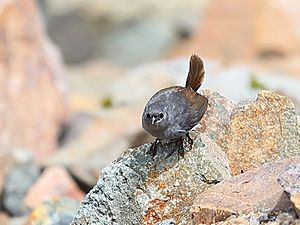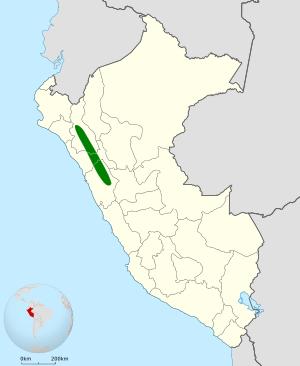Ancash tapaculo facts for kids
Quick facts for kids Ancash tapaculo |
|
|---|---|
 |
|
| Conservation status | |
| Scientific classification | |
| Genus: |
Scytalopus
|
| Species: |
affinis
|
 |
|
The Ancash tapaculo (scientific name: Scytalopus affinis) is a small bird that belongs to the tapaculo family, called Rhinocryptidae. This special bird is found only in Peru, which means it is endemic there.
Contents
About the Ancash Tapaculo
How It Got Its Name
The Ancash tapaculo was first described in 1939. At that time, scientists thought it was a type of Magellanic tapaculo. They called it Scytalopus magellanicus affinis.
However, in 1997, a new study looked closely at the sounds these birds make. Because their calls were so different, scientists decided the Ancash tapaculo was its own unique species.
What It Looks Like
Male Ancash tapaculos have a gray head and upper back. The rest of their upper body is dark brown. Their belly and chest are light gray. Their sides and under-tail feathers are a buffy (light brownish-yellow) color with clear stripes.
Female Ancash tapaculos look similar to males, but their upper parts are a bit browner. Young Ancash tapaculos (juveniles) have a brownish-gray head and upper back. The rest of their upper body is olive brown, and all these parts have stripes. Their underparts are gray, and their sides and under-tail feathers are olive brown with darker stripes.
Where It Lives
The Ancash tapaculo was first found in the Department of Ancash, Peru. Since then, it has also been seen in nearby areas like La Libertad, Huánuco, and Lima.
These birds live in high mountain areas. You can find them at elevations from about 9,800 feet (3,000 meters) up to 15,000 feet (4,600 meters).
Its Home Environment
The Ancash tapaculo prefers grassy areas in the mountains. It likes places with tall, clumpy grass and rocky spots. You can often find them near Polylepis woodlands or Gynoxys shrubs.
Ancash Tapaculo Behavior
What It Eats
Scientists don't know a lot about what the Ancash tapaculo eats or how it finds food. However, they believe it mostly eats insects.
How It Raises Its Young
Not much is known about how the Ancash tapaculo breeds. Two nests that were found looked like balls made of grass and moss, with an opening on the side. Young birds and eggs have been seen in February.
Its Calls and Songs
The Ancash tapaculo has a special song. It makes a "churr" sound that it repeats for 30 seconds or even longer. You can listen to an example here: Ancash Tapaculo Song.
It also has a "scold call," which is another "churr" sound. This call is longer and sounds drier than the notes in its song. Here's an example: Ancash Tapaculo Scold Call.
Conservation Status
The IUCN (International Union for Conservation of Nature) has looked at the Ancash tapaculo's situation. They have listed it as a species of "Least Concern." This means that even though it lives in a small area and we don't know its exact population size, the number of these birds seems to be stable. They are not currently in immediate danger.
See also
 In Spanish: Churrín de Áncash para niños
In Spanish: Churrín de Áncash para niños


